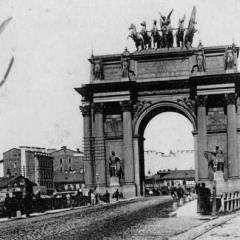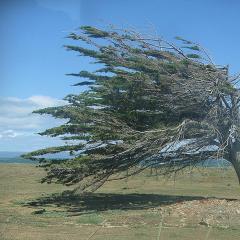Excursions along the Moscow Central Circle. Spontaneous tour of the MCC: life hack for the curious How to get on a tour of the MCC
Free excursions along the Moscow Central Circle (MCC) will be held for passengers daily on weekdays until October 10, 2016.
An excursion route for passengers has been launched on the Moscow Central Circle. Muscovites and guests of the capital will be able to learn about the sights of Moscow while traveling around the MCC on the Lastochka train. The first free excursions took place on the day the passenger service was launched and were in great demand among the townspeople. On September 12, a free excursion starts from the Luzhniki transport hub at 16:00. Such educational walks on the “Swallows” will be held regularly throughout the month, from Monday to Friday.”
Driving along the MCC, Muscovites and guests of the capital will be able to see Frunzenskaya Embankment, the Moscow City complex, VDNKh, the Luzhniki sports arena, as well as the Vorobyovy Gory nature reserve. During the trip, tourists will be told about the history of the Moscow Circular Railway, starting with its launch at the beginning of the 20th century. In total, there are about 86 architectural monuments of the Moscow Circular Railway, and all of these objects can be observed from the windows of the “Swallows”. The tour lasts approximately 84 minutes. This is the travel time of the Lastochka along the MCC, taking into account stops.
The ceremonial launch of passenger traffic on the MCC took place on September 10, 2016, City Day. The ceremony was attended by Russian President Vladimir Putin and Moscow Mayor Sergei Sobyanin.
Muscovites and guests of the capital will be able to use 26 stopping points on the MCC; the remaining five stops are planned to be launched before the end of 2016. According to expert estimates, the MCC will allow transportation of about 75 million passengers in the first year of operation and 120 million people by 2020. In 2025, passenger traffic will increase to 300 million people. In total, there will be 31 stations on the ring, at 17 stations you can transfer to 11 metro lines, and at 10 stations you can transfer to commuter trains. Of the 75 million people who are planned to be transported to the MCC in the first year, almost half will be metro passengers (34.5 million people), 20.2 million people - railway transport, 12.7 million - buses, 7.5 million passengers - residents of nearby houses.
MCC passengers will travel on Lastochka trains; train intervals will range from six minutes during peak hours and 11-15 minutes during off-peak times. The MCC will be fully integrated into the capital's metro system with unified ticket and tariff systems, navigation and travel rules for preferential categories of citizens: to travel on the ring, passengers will be able to use “United”, “90 minutes” and “Troika” tickets.
According to the decision of Moscow Mayor S. Sobyanin, during the first month of operation of the MCC, travel along the ring will be free. That is, you can go into the metro, transfer to the central ring, and then go back down to the subway, spending just one trip. To do this, passengers need to reprogram travel tickets purchased before September 1. This can be done at the metro and monorail ticket offices, as well as at the Metro Passenger Agency and the Moscow Transport service center. The validity period of the ticket and the balance of funds will not change.
P.S. Attention, rRegistration for excursions is closed!
You will travel along the circular railway and learn about the history of its construction, original engineering solutions and unfortunate miscalculations. Even if you pass a couple of MCC stations every day, you should take a ride around the entire large circle to get acquainted with the history and purpose of the road, which was conceived by Nicholas II. You will see modern, sometimes unsightly, but alive and always in a hurry to change Moscow.
Duration
Possible with children
3500 rub. for 1-5 people or 700 rub. per person if there are more of you
What awaits you
History of the Moscow Ring Railway
You will learn about how this road was built by order of Nicholas II and how it was planned to solve transport problems in Moscow at the beginning of the 20th century. I'll tell you about the industrial boom in Russia, which increased the load on the city center by 5% annually - the “golden-domed city” was simply suffocating from the amount of cargo. I will also reveal a second function: “aesthetic” - after all, the road was also supposed to serve as a decoration for the city.
The ring road is a symbol of progress
Let's talk about the first stages of construction, about individual projects, according to which 14 stations were built in a style typical of the Art Nouveau era, as well as numerous bridges, overpasses and even residential buildings. The Moscow District was of great national importance, so the best Russian engineers and architects were involved in the project! The road became a symbol of progress, and photographs of it were often used as a subject for postcards. Especially passenger stations and openwork bridges across the Moscow River.
Stages of development of the Moscow Ring Railway
I will tell you about how the ring road changed along with the new transport tasks of growing Moscow, and what difficulties arose along the way. At first it surrounded the city along the perimeter, but now the city has grown for many kilometers and the paths penetrate industrial zones, forests and large construction sites within the city. In the fall of 2016, the road became the Moscow Central Circle and opened its doors to passengers.
Panoramic view of Moscow
You will see residential areas and churches hidden in their depths, remnants of villages near Moscow, noisy highways, transport junctions and traffic jams, operating and inactive factories, shady parks and landfills. Among the iconic objects are Stalin's skyscrapers, VDNKh, Ostankino and Shukhov TV towers, the city of the future Moscow City, the islands of antiquity - the Novodevichy Convent and the Old Believer Bell Tower at the Rogozhskaya Outpost. Let's not ignore the stations - modern ones made of glass and concrete and restored historical ones, as well as many other interesting objects.

 +12
+12












Book a tour on any of the available days on the calendar
- This is a private tour, the guide will conduct it for you and your company.
- On the site you pay 23% of the cost, and the rest of the money goes to the guide on the spot. You can ask the guide any questions before paying.
Free day
Busy day
32% discount
I am the author of scripts for quests and walking tours around Moscow. I walked, read, ran and skied, bicycled and roller-skated through all the capital's parks, avenues, streets and alleys. I never tire of being amazed at how different Moscow can be. Businesslike and collected, elegant and formal, homely, cozy, spick and span elegant, and sometimes even mystical and mysterious. My excursions are a look at the present through the prism of the past. An attempt to solve riddles and answer questions.
More details
11 traveler reviews
Tripster does not disappoint as always. Everything is wonderful. Interesting, Galina is smart, let’s talk again.
Wonderful excursion! Very informative, interesting, not too tiring. Galina organized the material perfectly, thought through everything down to the smallest detail. Part of the excursion takes place in MCC carriages, part - at stations. Almost everywhere you can listen while sitting, which is important if there are children or elderly people in the company. We are Muscovites, but we learned a lot about our city. I would like to especially note Galina’s positive attitude, her friendliness and charm. Thank you!
Five months have passed since the opening of traffic on the Moscow Central Circle. Comfortable red electric trains have ceased to be perceived as exotic, but have become a familiar mode of transport for many. But still, not all Muscovites and guests of the capital managed to ride around the entire ring. I had some free time and decided to go full circle.
2. It’s the height of the working day, there are not very many people, but the platforms cannot be called empty either. , transition to the Avtozavodskaya metro station. 
3. Swallows come often. 
4. Who ordered a taxi to Dubrovka? Today we will go by electric train. 
5. Basically, the MCC route passes through industrial areas. There are unexpectedly many hypermarkets and shopping centers along the route. 
6. A new Zilart quarter is being built somewhere here. 
7. Promised lifehack:
Previously, it was possible to travel along the MCC with a free excursion. I regret that I never got around to getting out. For those who were unable to take the tour, the management of the Moscow Metro promised to launch an audio guide by the end of 2016, unfortunately, I did not find it. I suspect that they never made an audio guide.
But, after searching for information on the Internet, I found a page with a good amateur audio tour. The excursion consists of 30 fragments, carefully divided into stages. It is very convenient to drive and listen to what is outside the window.
The audio tour is a little outdated, since several previously closed stations have opened since the recording, but the information is still useful and interesting. Thanks to the authors!
Link to audio tour of the MCC: https://vk.com/audios-129204178, sit back by the window and enjoy. That's exactly what I did. 
8. Shopping complex "Gorod". 
9. Don’t forget that the MCC is the brainchild of not only the metro, but also Russian Railways. Therefore, fans of diesel locomotives and other trainspotting will find a lot of interesting things for themselves. If only the windows were cleaner. 
10. Some more railway equipment. 
11. Hotel “Izmailovo”, the MCC station of the same name is located very close. 
12. Note to non-residents. 
13. Izmailovo Kremlin. There is a good view of it. 
14. Somewhere in the area of the former Cherkizon. 
15. It’s interesting to watch not only the city, but also the people. 
16. "Elk Island". 
17. Another shopping center. 
18. 
19. “Swallow” drives very quietly and smoothly, you can take a little nap. At the same time, at times the electric train accelerates to almost 100 kilometers per hour. 
20. The snow is being removed. 
21. We reached Vladykino. 
22. 
23. 
24. We pass by the Botanical Garden. From here you can see perfectly. 
25. We pass Swallow's Nest. 
26. The Sorge platform, named after the famous Soviet intelligence officer. 
27. CSKA stadium with a building in the shape of the UEFA Cup. 
28. We are approaching Moscow City. Station "Business Center". 
29. This station was nicknamed the “Emerald City”. An amazing and awkward architectural solution. 
30. We are leaving the City. 
31. Moscow is always standing somewhere. 
32. 
33. Let's move. We see the center of Moscow, the Crimean Bridge and the monument to Peter the Great. 
34. Moscow city graffiti. 
A little more and I get off at the same station where I got off. Travel time is approximately 80 minutes.
This is such a spontaneous excursion. There is an idea to take another ride when it gets warmer, I will need to get ready and wash the window on the train.
By the way, the Museum of Moscow conducts official tours of the MCC.
The ticket price is 300 rubles, the schedule is on the museum website.
If you go on your own, the excursion will be quite cheap, remember that the transfer from the metro to the MCC is free, and the audio tour is available on the Internet. An excellent option for a walk and exploring the city, even for those who live in it. You can start and end the excursion anywhere, without depending on anyone.
Address: Moscow, TPU Business Center, Mezhdunarodnaya metro stationOn a tour of the Moscow Central Circle, you will learn about the history of the construction of the Circular Railway, the origin of the station names, the events that took place in the areas adjacent to the Moscow Central Circle: the childhood of Peter the Great and his famous Kozhukhov campaign, what happened before on the territory of the ZIL plant, and what we will see there in the near future, about where M. N. Ermolova was buried, why the Rostokinsky aqueduct was called the “millionth bridge,” and what Tanka Rostokinskaya became famous for.
The excursion is free (travel costs are not included in the excursion). Travel to the MCC can be paid using tickets (“United”, “90 minutes”, “Troika”). There is a free transfer between the Moscow metro, the Moscow monorail and the MCC for 90 minutes after the first passage through the turnstile.
Until the spring of 2017, excursions were held free of charge, now the cost is 300 rubles, preferential* - 250 rubles.
Each participant is given a radio guide for excellent audibility. We recommend bringing your own headphones. You must have a deposit of 1000 rubles with you. or an identity document. Equipment must be returned after the excursion.


